Variety of Dried Fruits and Nuts
Kuruyemiş (pronounced koo-roo-yay-meesh) refers to a broad variety of dried fruits, nuts and so much more. In Turkey kuruyemiş is not just an important food group but has great social significance and refers to a genre of food associated with happy times as well as social and entertainment experiences. Kuruyemiş can be found in beautiful and abundant displays at every local Pazar (outdoor market), many grocery stores and even special little kuruyemiş shops. In the article below I will explain some of the variety included in kuruyemiş and its significance.
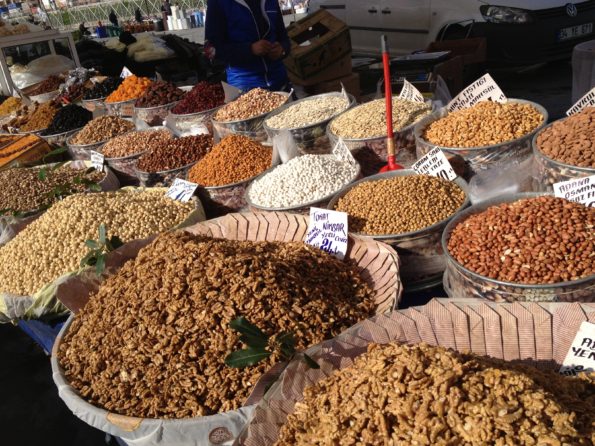 A large array of nuts such as I’ve never witnessed outside of Turkey is sure to delight everyone who stops to shop. Turkey is the world’s largest exporter of hazelnuts, most of which are grown along the northern Black Sea Region. The southern province of Gaziantep is responsible for producing so many wonderful pistachios that the Turkish name for this nut is Antep fıstığı which literally translated means the nut of Gaziantep. Pistachios are used for many special dishes in that region including the famous and oh-so delicious Antep Baklava. Other nuts abundantly available in Turkey at kuruyemiş stalls are almonds, walnuts and peanuts. Cashews and pine nuts are quite expensive but also available in most places and used in a variety of Turkish cuisine such
A large array of nuts such as I’ve never witnessed outside of Turkey is sure to delight everyone who stops to shop. Turkey is the world’s largest exporter of hazelnuts, most of which are grown along the northern Black Sea Region. The southern province of Gaziantep is responsible for producing so many wonderful pistachios that the Turkish name for this nut is Antep fıstığı which literally translated means the nut of Gaziantep. Pistachios are used for many special dishes in that region including the famous and oh-so delicious Antep Baklava. Other nuts abundantly available in Turkey at kuruyemiş stalls are almonds, walnuts and peanuts. Cashews and pine nuts are quite expensive but also available in most places and used in a variety of Turkish cuisine such as the traditional dessert of İrmik Helvası. While nuts are enjoyed plain as a snack, served to guests and enjoyed during special festivals, they are also a very important ingredient in Turkish cuisine such as walnuts in the creamy Haydari salad, the meat-filled pastry called Ağzı Yumuk, or as a lovely accent to Candied Pumpkin. Walnuts are also used in the popular cevizli sucuk (as pictured here). While the literal translation is sausage with walnuts there is no meat involved except that of the walnuts. After walnuts are strung together on a string a thick molasses is used to coat them which dries and looks like a tube of sausage.
as the traditional dessert of İrmik Helvası. While nuts are enjoyed plain as a snack, served to guests and enjoyed during special festivals, they are also a very important ingredient in Turkish cuisine such as walnuts in the creamy Haydari salad, the meat-filled pastry called Ağzı Yumuk, or as a lovely accent to Candied Pumpkin. Walnuts are also used in the popular cevizli sucuk (as pictured here). While the literal translation is sausage with walnuts there is no meat involved except that of the walnuts. After walnuts are strung together on a string a thick molasses is used to coat them which dries and looks like a tube of sausage.
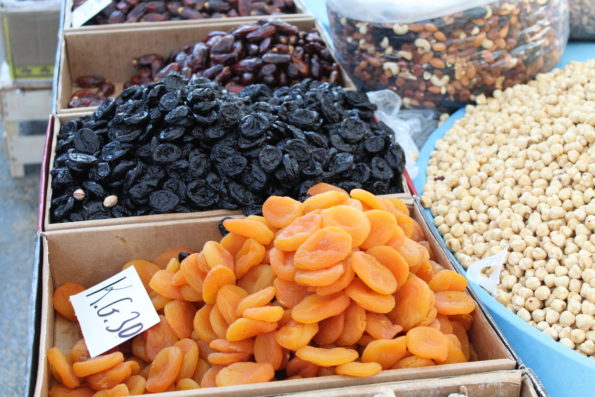
Dried fruit is an undeniably important part of the kuruyemiş genre. Turkey is the largest producer of both apricots and figs. The Eastern Anatolian province of Malatya is known for their delicious apricots and is the largest exporter in the world. While fresh apricots are only enjoyed for a short season, kuruyemiş shops have a large variety of dried apricots everyday of the year to satisfy both locals and tourists alike. Dried apricots aren’t always the autumnal orange like we think of in the States. Apricots that are naturally sun-dried without any chemicals are dark brown or reddish brown (see picture at the very bottom of this article). As mentioned earlier, Turkey also produces and exports the largest number of figs in the world. Nothing compares to a fresh purple fig in September! But again although the season for fresh figs is very short, dried figs are enjoyed all year long. The surrounding Middle Eastern countries produce a great variety of dates which can be found at every kuruyemiş stall. Before living in Turkey I didn’t know there were so many types of dates possible! Another unique kuruyemiş find are dried white mulberries. An abundance of raisins, prunes, and dried cranberries are also popular. Dried fruit and other kuruyemiş are especially important during the winter months when not as much fresh fruit is available and the nights are long and dark, making this the perfect offering to guests as you sit and visit away the hours.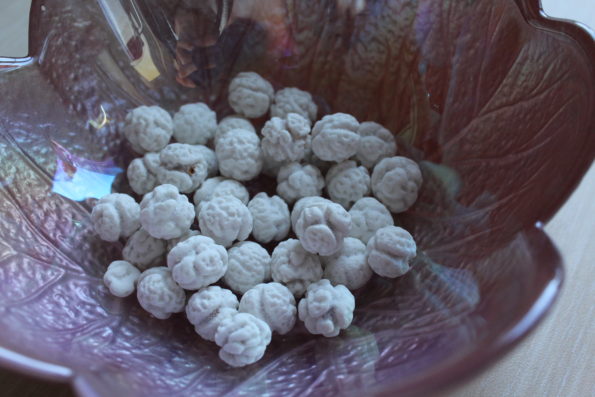
Leblebi are roasted chickpeas (garbanzo beans). These also come in great quantity and a large variety: from plain roasted, to salted and spiced, to a personal favorite where chickpeas are coated in sugar (as in the picture here). These little protein packed spheres are tasty in a variety of ways and when dried are easy to eat by the handful. Çerez is a term for a mixture of dried nuts, seeds, leblebi, and corn nuts. Small dishes of çerez are served to guests at weddings or in home, especially during special holidays. These make the perfect snacking addiction since it’s easy to pop some in your mouth every minute or so while visiting with friends for many hours.
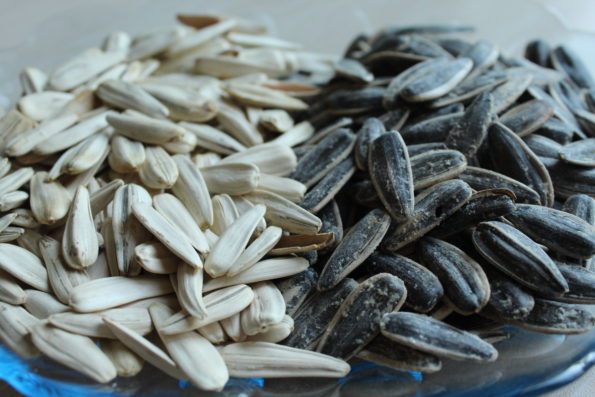 Çekirdek is one of the most noticeable snack foods in Turkey. This word literally means seed, but as a snack food in the kuruyemiş family it encompasses both black and white sunflower seeds, pumpkin seeds and even roasted and salted watermelon seeds. My Turkish friends were appalled to watch me try and eat sunflower seeds which was a tedious process involving my hands. They laughed and couldn’t comprehend how I didn’t know how to simply use my tongue and teeth to quickly get the seed out of the shell so it could be eaten. I practiced for hours but still haven’t mastered it. Needless to say my Turkish friends have thousands of hours more practice behind them as it’s a favorite snack – and pastime – for Turks from small children to elderly grandparents. Around every park bench and all along walkways you can see mounds of sunflower seed shells indicating people were there visiting with one another or just munching away while watching other people pass by and enjoying nature.
Çekirdek is one of the most noticeable snack foods in Turkey. This word literally means seed, but as a snack food in the kuruyemiş family it encompasses both black and white sunflower seeds, pumpkin seeds and even roasted and salted watermelon seeds. My Turkish friends were appalled to watch me try and eat sunflower seeds which was a tedious process involving my hands. They laughed and couldn’t comprehend how I didn’t know how to simply use my tongue and teeth to quickly get the seed out of the shell so it could be eaten. I practiced for hours but still haven’t mastered it. Needless to say my Turkish friends have thousands of hours more practice behind them as it’s a favorite snack – and pastime – for Turks from small children to elderly grandparents. Around every park bench and all along walkways you can see mounds of sunflower seed shells indicating people were there visiting with one another or just munching away while watching other people pass by and enjoying nature.
Kuruyemiş is not just delicious with endless variety but something good to have on hand for when guests drop by to visit. While a healthy and sustaining snack for one to enjoy alone, as Turkish hospitality teaches us everything is better when enjoyed with friends and some good conversation!
Delicious Dates
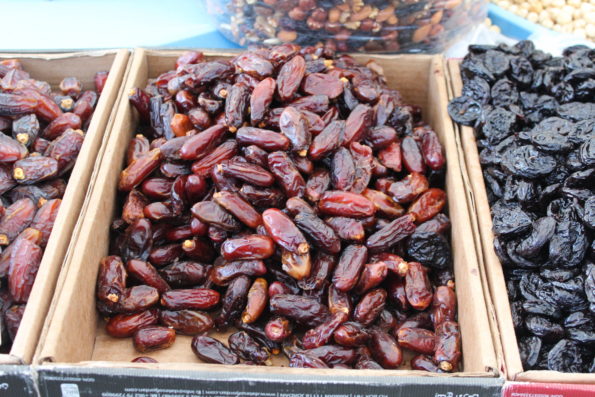
Walnuts galore!

Dried Figs

Sun-dried Apricots & Raw Almonds


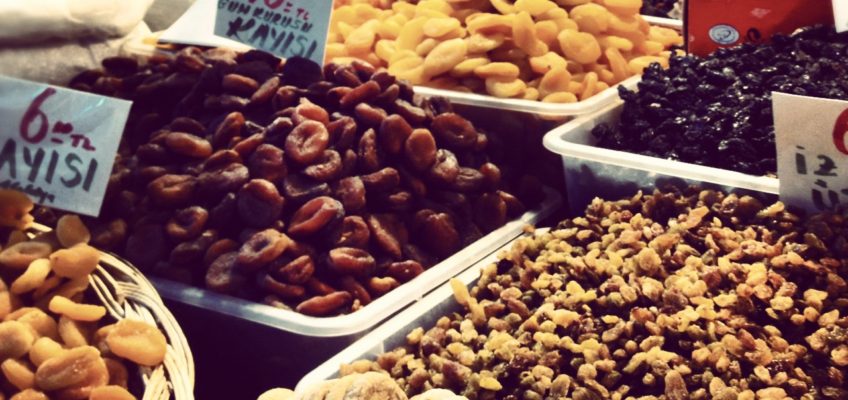

John
I love nuts myself & found it interesting to hear more about them.
John
I love nuts & found your article very interesting!
John Lapinski
Turkish apricots and figs beat any American fruit